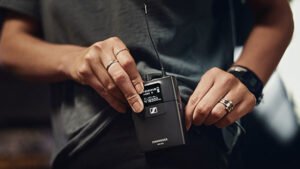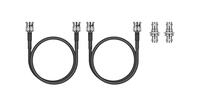With a resurgence of live Definition:
Definition:
Live broadcast of an event or program without substantial delay or editing. music after several long and lonely years, musicians are looking to get back out there, and gear Definition:
Definition:
Musical or performance equipment. manufacturers are eager to make sure they have what they need. Musicians have been reconsidering how they want to approach live performance, and one of the trends we’re seeing is a strong interest in wireless in-ear monitoring (IEM Definition:
Definition:
IEM (In-Ear Monitor): Earphones for musicians or announcers to hear program material, foldback, and IFB (Interrupt for Broadcast) audio. IEMs eliminate the need for listening to loudspeakers or monitor wedges. Often wireless.).

Musicians are eager to pursue the possibilities of both IEMs and wireless systems, but they’re faced with a confusing number of options — from cheaper systems that make a lot of promises they might not be able to keep up to high-end pro systems that can be hard to configure Definition:
Definition:
1. To alter the way in which software interacts with a computer system in order to make the software compatible with a specific set of peripherals. 2. To alter parameters in a system's hardware elements so that they can work together in a system context. and back-breakingly expensive.
Wouldn’t it be nice if one of the most respected names in wireless came out with a new system that was far more affordable than their previous lines, so simple to set up that anyone could be up and running in a matter of minutes, and sounded amazing?
Sennheiser has just added in-ear monitoring to its affordable, powerful XS lineup of wireless mic systems. The XS Wireless In-Ear Monitoring Set (XSW IEM) is a pretty remarkable little setup. But before we get into the details, let’s answer a couple of questions that newcomers might have.
What’s the point of wearing in-ear monitors on stage?
In-ear monitors (IEMs) can be as simple as earbuds. In fact, most people start out using earbuds! Rather than sitting outside the ear, they insert into the ear canal to block out sound from outside. Universal fit IEMs will come with a variety of ear tips in different shapes and sizes to fit snugly but comfortably.
Musicians who find themselves really enjoying the in-ear experience will often go to an audiologist, have molds made of their ear canals, and use those to purchase custom IEMs. These tend to be more costly but offer better isolation, easier donning and removal, and top-quality sound. Besides, it’s cool to own a piece of music gear that literally nobody else can use because it only fits you.

Once you’re on stage with your IEMs, the monitor mix engineer sends you precisely what you want to hear, in the right proportions, in stereo Definition:
Definition:
A two channel signal simulating a sound space, typically played through two speakers.. You can listen at a much lower level and still hear everything because the IEMs seal out a lot of the PA Definition:
Definition:
(Public Address) A sound system intended to provide audio coverage to large groups of people. and venue noise. Some designs let in a tiny bit of ambience, so you don’t feel isolated or disoriented on stage.
Because you’re getting your monitor mix inside your own head, it doesn’t need to be blasted at you from outside. So you don’t have monitor wedges aimed at you, adding to the onstage sound pressure level Definition:
Definition:
A measurement of sound amplitude in the air expressed in decibels, referencing 0 dB SPL = 20 micro Pascals = 0.0002 dynes/cm2. and potentially causing feedback Definition:
Definition:
1. A squealing, chirping, or ringing sound when a microphone feeding a loudspeaker picks up audio from that loudspeaker. Also called howlround. 2. The state where a device's output connects back to the input. issues.
With the right monitor mix set up to not interfere with Front of House, you can even speak to your bandmates and the engineers without having to shout. There will always be folks who prefer wedges, but IEMs are making more converts every day.
Isn’t wireless risky and hard to set up?
A wireless system consists of two pieces: a transmitter (TX), which takes audio and turns it into a radio signal, and a receiver (RX), which accepts those signals and turns them back into audio.
Wireless systems have been around for years. They’re primarily used for microphones — for presenters, on-air talent, and performing artists who can’t be tied to one place. However, wireless IEM systems are becoming more and more common.
Wireless has a reputation for being funky on stage and not terribly reliable. We all remember that scene from This Is Spinal Tap where Nigel Tufnel’s guitar starts playing air traffic control signals!
However, while certain aspects of touring (bad promotion, lousy food, and the occasional interfering life partner) haven’t changed much over the years, wireless technology has gone through several revolutions, providing more reliability and adhering to much more stringent controls over who can use which frequencies for what.
If you stop to think about it, the electromagnetic spectrum is shared by everyone in the world (and beyond), doing everything that doesn’t require cables: AM Definition:
Definition:
AM (Amplitude Modulation): A method for varying the level of a RF carrier frequency or audio signal with another signal (audio or sub-audio). and FM Definition:
Definition:
FM (Frequency Modulation): A method of transmitting audio with minimal noise. The waveform being modulated is called the carrier and the modulating waveform, the modulator. radio, television, airplane navigation, ships at sea, weather and communications satellites, and even ham radio.
Many of the largest live tours retain engineers whose sole job is making sure that the dozens of wireless channels on stage don’t interfere with one another or with the installed wireless systems in places surrounding that night’s venue.
Smaller bands generally have to figure this stuff out for themselves, but modern wireless systems help make the process very easy and straightforward. It’s never been easier and more reliable to get into wireless, whether for your in-ears or your guitar.
Welcome to XS Wireless
Sennheiser is renowned for everything from microphones to headphones, and they’re well-respected for high-quality wireless systems as well. From large professional systems to the Evolution Wireless line, Sennheisers have graced a lot of stages, concert halls, universities, and houses of worship.
The XS series is designed to be affordable, really easy to set up, and flexible while still providing Sennheiser’s renowned reliability and good sound. There are a variety of XS wireless microphone Definition:
Definition:
A microphone with a transmitter that sends radio-frequency signals to link wireless with a receiver, obviating the need for a cable. sets on the market already, and the XSW IEM now adds in-ear monitoring to the package.
The XSW IEM experience
While some components are available separately, new users will usually buy them as part of the XSW IEM Set, which contains:
- The XSW EK receiver bodypack
- The XSW SR tabletop/rackmount transmitter
- A removable antenna
 Definition:
Definition:
A device for radiating or receiving electromagnetic signals. with a locking BNC connector Definition:
Definition:
BNC (Bayonet-Nut Coupler) Connector: A twist-lock co-axial RF (radio frequency) connector used for professional video, digital audio and antenna connections. - The NT 12-5CW universal power adapter (with plugs for the US, EU, UK, and China)
- A rack mounting kit for either a single SR unit or two of them side by side
- A pair of Sennheiser IE 4 earbuds with an assortment of ear tips
A small illustrated quick start sheet has clear pictorial instructions to get you off and running in no time. The Sennheiser Documentation app for iOS Definition:
Definition:
Apple proprietary operating system, primarily for mobile devices (iPhone, iPad, iPod Touch, Apple Watch). Current Apple TVs run on tvOS, which is similar to, and based on, iOS. and Android has more detailed materials online.
Initial setup is incredibly easy: attach the SR’s antenna, plug it in, run a stereo audio signal into it (the rear panel accepts 1/4" or XLR), and turn it on. Then pop two AA batteries into the EK’s easy-open battery Definition:
Definition:
An assembly of series-wired cells that provides higher voltages than individual cells. compartment, turn it on with the volume knob, and plug your IEMs into the top-edge 3.5 mm minijack. Clip the bodypack to your belt or guitar strap, put on your IEMs, adjust the volume, and you’re off and running!
Both the SR and the EK have bright, easy-to-read OLED Definition:
Definition:
(Organic Light Emitting Diode) A high-quality light-emitting display, based on organic compounds and not requiring a backlight (and therefore capable of creating true blacks), used in video and portable displays. displays that display transmission frequency Definition:
Definition:
A value, expressed in Hertz, that indicates how many cycles of a periodic signal occur in one second. , system parameter settings, and bar graphs for audio signal levels and reception strength. The EK’s display will automatically shut off after 30 seconds to save battery power.
The SR has a SYNC Definition:
Definition:
To make two or more pieces of equipment or signals synchronize with each other. button to establish a connection with the EK if needed. Our unit came ready to go out of the box. The EK has a small LED Definition:
Definition:
LED (Light-Emitting Diode): A semiconductor light generator used in displays, television, pointers and for general illumination. It is a low-power replacement for incandescent lamps. to indicate a good or failed link and flashes when the batteries run low.
Each unit has a SET button and up/down arrows for navigation through their functions. The EK’s buttons are hidden inside the battery compartment, as you usually wouldn’t want them exposed while in use.
The XSW IEM uses the frequency range of 476 to 500 MHz Definition:
Definition:
Abbreviation for Megahertz. 1,000,000 Hertz, or one million cycles per second. and can tune its frequencies in increments of 0.25 MHz if needed. However, a wide range of preset Definition:
Definition:
1. (verb) Ability to set parameters in advance, and recall those parameter values as desired. 2. (noun) A collection of parameter values stored within a device, or externally. channels will give nearly any user what they need.
Channels are organized in eight banks of 12 channels each. Sennheiser advises that users choose a single bank and distribute channels among multiple XSW IEM units rather than spreading out over multiple banks to avoid confusion and keep frequencies from interfering with each other. Plus, you know, your other band members will all eventually want one.
The SR can set mono Definition:
Definition:
Short for Monophonic. An audio program, recording, or hardware device/software routine that produces or processes a signal with only one channel. or stereo transmission, bank and channel Definition:
Definition:
1. In radio, television, citizen's band radio, and other wireless communications modes, a specific frequency for communication. 2. In mixers and video, an input or output signal path with controls. 3. In MIDI, one of 16 data paths. numbers, frequency tuning, and gain Definition:
Definition:
The amount of amplification provided by an amplifier circuit, expressed in dB or numerically as in "3X" = "3 times". between -21 dB Definition:
Definition:
1. A deciBel is a logarithmic ratio between two quantities, and is a nonlinear measurement that mimics human perception. 2. A unit expressing sound levels relative to a nominal level just audible by the average human ear, and equal to 1/10th of a Bel. and 0 dB in 3 dB steps (tip: set it so the meters are maxed, but the PEAK Definition:
Definition:
A signal's maximum level at any point in time. indicators don’t flash).
The EK offers similar controls to match the SR’s settings but uses the volume knob rather than a gain setting. It also offers three on/off options for the user’s tastes: a built-in limiter Definition:
Definition:
A form of compressor with a ratio of infinity:1 above the threshold for both overload protection, or as a sound effect to normalize volume. Some engineers consider a compressor with a ratio of 20:1 or higher above the threshold a limiter., a slightly tweaked EQ setting, and a focus Definition:
Definition:
1. (stage lighting) To aim and adjust a lighting instrument. 2. (photography) To adjust a camera for the sharpest image. setting that strongly de-emphasizes signals in the far left and right channels.
The focus setting allows you to run two independent Definition:
Definition:
A electrical circuit that is separate for lighting control, or a light board channel independent of other controls or programming. channels into the unit and use the pan Definition:
Definition:
Horizontal pivot of a camera or light, opposite of Tilt, or the placement of a sound element in stereo or surround sound. control to mix between the two. This feature can help those “more me” situations by having the band in one channel and your instrument or voice in the other. That way, you can easily dial in the volume of your instrument. And it also can support two users with entirely different mono mixes.
Finally, a pan control lets the user shift the mix from full left to full right, compensating for existing level imbalances or allowing the user to have one ear silent to hear outside sounds.
As simple and reliable as in-ear monitors get
Our tests of the XSW IEM Set were comfortingly easy and uniformly excellent. We were set up in a bit over five minutes — including unboxing, reading the instructions, and getting the %@#&!! shrink wrap off the batteries.
The transmitter offers excellent range in the open air – up to 100 meters or about 330 feet. We did some torture tests for interference and couldn’t get the EK to glitch out — and the sound quality was fantastic, clear, and powerful with a great signal-to-noise ratio Definition:
Definition:
Abbreviated SNR. The ratio in dB between the noise floor and a nominal signal level (not the maximum level, which instead defines the Dynamic Range. See Dynamic Range.).
Wireless monitoring doesn’t have to be scary. Sennheiser’s reputation for amazing quality and ease of use has taken on a whole new form in the XS Wireless In-Ear Monitoring Set. And there’s now a much lower barrier for musicians or bands to get into the wireless IEM game and see (and hear) what it can do for their show setup, peace of mind, and musical enjoyment.


















